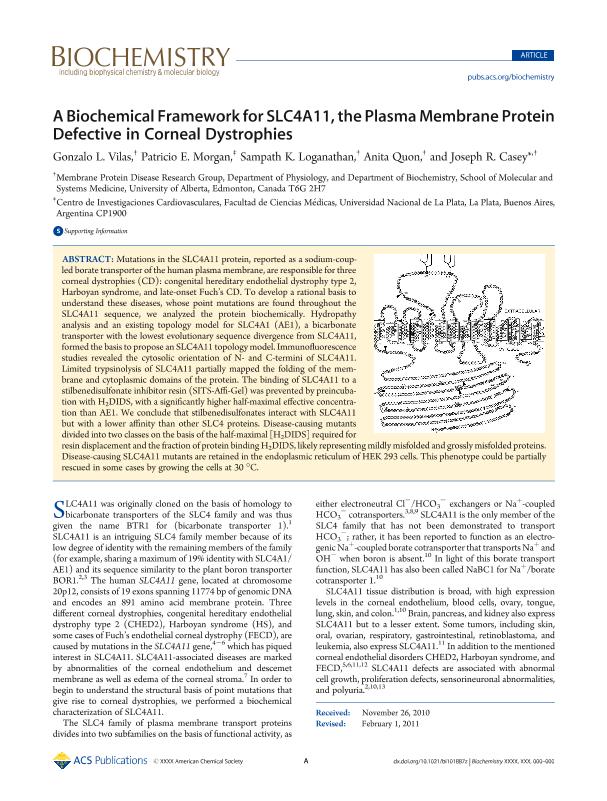Mostrar el registro sencillo del ítem
dc.contributor.author
Vilas, Gonzalo L.
dc.contributor.author
Morgan, Patricio Eduardo

dc.contributor.author
Loganathan, Sampath K.
dc.contributor.author
Quon, Anita
dc.contributor.author
Casey, Joseph R.
dc.date.available
2018-09-26T15:31:25Z
dc.date.issued
2011-03
dc.identifier.citation
Vilas, Gonzalo L.; Morgan, Patricio Eduardo; Loganathan, Sampath K.; Quon, Anita; Casey, Joseph R.; A biochemical framework for SLC4A11, the plasma membrane protein defective in corneal dystrophies; American Chemical Society; Biochemistry; 50; 12; 3-2011; 2157-2169
dc.identifier.issn
0006-2960
dc.identifier.uri
http://hdl.handle.net/11336/60873
dc.description.abstract
Mutations in the SLC4A11 protein, reported as a sodium-coupled borate transporter of the human plasma membrane, are responsible for three corneal dystrophies (CD): congenital hereditary endothelial dystrophy type 2, Harboyan syndrome, and late-onset Fuch’s CD. To develop a rational basis to understand these diseases, whose point mutations are found throughout the<br />SLC4A11 sequence, we analyzed the protein biochemically. Hydropathy analysis and an existing topology model for SLC4A1 (AE1), a bicarbonate transporter with the lowest evolutionary sequence divergence from SLC4A11, formed the basis to propose an SLC4A11 topology model. Immunofluorescence studies revealed the cytosolic orientation of N- and C-termini of SLC4A11.<br />Limited trypsinolysis of SLC4A11 partially mapped the folding of the membrane and cytoplasmic domains of the protein. The binding of SLC4A11 to a stilbenedisulfonate inhibitor resin (SITS-Affi-Gel) was prevented by preincubation with H2DIDS, with a significantly higher half-maximal effective concentration than AE1. We conclude that stilbenedisulfonates interact with SLC4A11 but with a lower affinity than other SLC4 proteins. Disease-causing mutants divided into two classes on the basis of the half-maximal [H2DIDS] required for resin displacement and the fraction of protein bindingH2DIDS, likely representing mildly misfolded and grossly misfolded proteins. Disease-causing SLC4A11 mutants are retained in the endoplasmic reticulum of HEK 293 cells. This phenotype could be partially rescued in some cases by growing the cells at 30 C.
dc.format
application/pdf
dc.language.iso
eng
dc.publisher
American Chemical Society

dc.rights
info:eu-repo/semantics/openAccess
dc.rights.uri
https://creativecommons.org/licenses/by-nc-sa/2.5/ar/
dc.subject
Slc4a11
dc.subject
Eye
dc.subject
Distrophy
dc.subject
Structure
dc.subject.classification
Medicina Critica y de Emergencia

dc.subject.classification
Medicina Clínica

dc.subject.classification
CIENCIAS MÉDICAS Y DE LA SALUD

dc.subject.classification
Fisiología

dc.subject.classification
Medicina Básica

dc.subject.classification
CIENCIAS MÉDICAS Y DE LA SALUD

dc.title
A biochemical framework for SLC4A11, the plasma membrane protein defective in corneal dystrophies
dc.type
info:eu-repo/semantics/article
dc.type
info:ar-repo/semantics/artículo
dc.type
info:eu-repo/semantics/publishedVersion
dc.date.updated
2018-09-10T16:43:17Z
dc.journal.volume
50
dc.journal.number
12
dc.journal.pagination
2157-2169
dc.journal.pais
Estados Unidos

dc.description.fil
Fil: Vilas, Gonzalo L.. University of Alberta; Canadá
dc.description.fil
Fil: Morgan, Patricio Eduardo. Universidad Nacional de La Plata; Argentina. Consejo Nacional de Investigaciones Científicas y Técnicas. Centro Científico Tecnológico Conicet - La Plata. Centro de Investigaciones Cardiovasculares ; Argentina
dc.description.fil
Fil: Loganathan, Sampath K.. University of Alberta; Canadá
dc.description.fil
Fil: Quon, Anita. University of Alberta; Canadá
dc.description.fil
Fil: Casey, Joseph R.. University of Alberta; Canadá
dc.journal.title
Biochemistry

dc.relation.alternativeid
info:eu-repo/semantics/altIdentifier/url/https://pubs.acs.org/doi/abs/10.1021/bi101887z
dc.relation.alternativeid
info:eu-repo/semantics/altIdentifier/doi/http://dx.doi.org/10.1021/bi101887z
Archivos asociados
